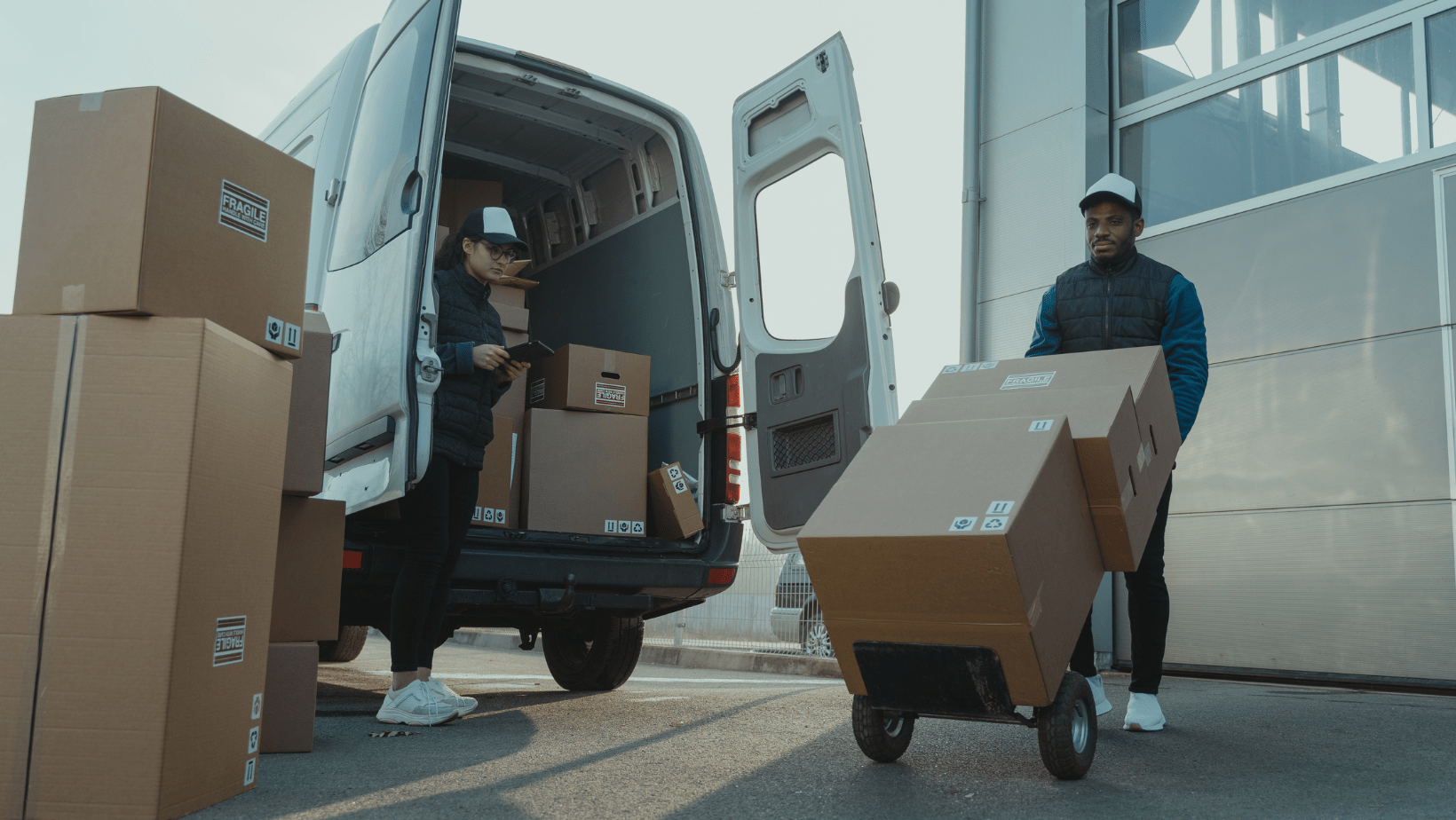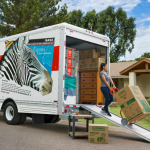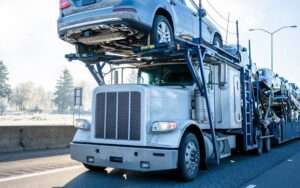Navigating the Logistics of Interstate Move
March 5, 2024
Moving to a new home in a different state can be an exciting but challenging process. There are many logistical details involved in coordinating an interstate move that require careful planning and preparation. This guide will provide an overview of the key steps involved in navigating the logistics of an interstate move, from deciding what to take with you to changing your address once you arrive at your new home.
Moving between states brings added complexity compared to an intrastate move. You’ll need to coordinate timing with movers traveling a longer distance, be prepared for extra paperwork and regulations when crossing state lines, and account for potential delays and other challenges inherent to longer moves. With smart planning and organization, you can ensure your interstate move goes as smoothly as possible.
In this guide, we’ll cover choosing a moving company, creating a timeline, preparing your items for transport, understanding regulations and insurance, tracking your shipment, and unpacking and getting settled in your new home. By knowing what to expect at each step of the process, you can avoid hassles and feel confident that your move will be successful. Whether you’re moving for a new job or other life change, our tips will help you navigate the logistics of your interstate move.
One of the first steps when preparing for an interstate move is deciding what to take with you and what to leave behind. This is a good opportunity to thoroughly evaluate your belongings and pare down your possessions.
Take stock of everything you own and sort items into categories:
As you assess your belongings, consider the following:
Aim to be selective and move only essential, useful items. If you haven’t used something in over a year, it may not be worth moving.
For items you plan to donate or sell, look for local charities, thrift stores, consignment shops, or online platforms. This can benefit those in need and earn you extra income.
Anything broken, worn out, or useless should be discarded and recycled if possible. Go through every room, closet, drawer, and storage area. The less you move, the easier and more affordable your move will be.
The moving process also presents a great opportunity to reset and start fresh. Don’t feel obligated to move items out of habit or sentiment if they no longer fit your lifestyle.
When preparing for an interstate move, one of the biggest decisions is whether to hire professional movers or do it yourself. There are pros and cons to each approach.
Professional Movers
Hiring professional movers takes much of the stress and heavy lifting out of moving. Reputable companies will have trained staff, insurance coverage, and the right equipment to safely transport your belongings long distances. This option costs more but may be worth it for the convenience and peace of mind.
DIY Moving
For more budget-conscious individuals, you may opt to do it yourself. This takes considerable time and effort but costs less. You must rent a truck, pay for insurance, gas, tolls, and hotel stays. Lifting heavy furniture and driving long distances can also be challenging.
Carefully weigh the tradeoffs of professional vs DIY moving to decide what best suits your relocation needs and budget.
The timeline for an interstate move often begins 4-8 weeks before your moving dates. This provides enough time to prepare, sell items, pack, schedule movers, and handle any last minute details.
When scheduling your interstate move, consider the following timeline:
Securing your moving dates as early as possible ensures availability as movers book up quickly in peak season. Give yourself enough time to prepare methodically, without last-minute stresses. Advance planning helps make moving interstate smooth and efficient.
The key to ensuring a smooth move is proper packing and preparation. Start by decluttering and getting rid of items you no longer need or want. This will reduce the amount you have to pack and move.
When packing, use sturdy boxes in good condition and fill them to the top. If they collapse, repack with more items. Seal boxes tightly with packing tape. Label each box clearly with the contents and the room it should go in at your new home. This will help movers know where to put each one.
Use specialty boxes for mattresses, wardrobe boxes for hanging clothes, and disassemble furniture to move it more easily.
Wrap fragile items individually in bubble wrap or paper. Use dish packs and extra padding for plates, glasses, and valuables.
Pack a travel bag with medications, valuables, and other essentials to take with you rather than having movers transport it.
Create a detailed moving inventory with all items you’ll be moving. Note condition, value, and box number. Take photos of expensive items before packing. Update your inventory as you finish packing each room.
Keep all moving documents together in a file folder. This includes the moving inventory, receipts, bill of lading, and tracking numbers.
Proper preparation and diligent packing will give you greater peace of mind on moving day.
One of the biggest logistical considerations when moving interstate is how you’ll transport your belongings and where you’ll store them if needed. You have several options to weigh:
Renting a moving truck and driving it yourself is often the most flexible and affordable option. U-Haul, Penske, Budget, and other rental companies let you pick up a truck locally and drop it off at your destination. Consider the size you’ll need based on your possessions. Factor in fuel costs for the drive. And keep in mind that driving a loaded moving truck is very different from a regular vehicle!
The interstate moving industry has a surprisingly large carbon footprint. On average, a long-distance move emits over 3 tons of carbon into the atmosphere. This is equivalent to the emissions from driving a car 7,500 miles. With over 35 million Americans moving households each year, the environmental impact starts to add up quickly.
Reducing the carbon emissions of moving is becoming increasingly important. As climate change progresses, individuals and businesses alike are looking for ways to reduce their carbon footprints. The moving industry has lagged behind other sectors in prioritizing sustainability. But with rising eco-consciousness, there is growing consumer demand for responsible moving practices. More people want to move in an environmentally-friendly way.
The carbon emissions from moving matter because they contribute to climate change. Moving sustainably is one impactful way for households to lower their annual carbon footprint. With some planning and preparation, families can reduce the environmental impact of their move. Eco-moving options are on the rise, providing ways to move greener.
Interstate moves tend to have high carbon emissions for several reasons. The primary factor is the fuel usage of large moving trucks traveling long distances across states. A typical interstate move may involve a heavy 26-foot rental truck driving over 1,000 miles. With an average fuel economy of only 7 miles per gallon when loaded, this can result in over 140 gallons of diesel fuel burned just for the moving truck.
In addition to the truck’s emissions, the disposable packing materials used to protect belongings can also have a significant environmental impact. Bubble wrap, paper, tape, boxes, and other packaging are often used in large quantities for an interstate move. Most of these materials are discarded after use, ending up in landfills. The resources and energy used to produce these materials further contribute to the emissions footprint.
The total distance traveled is also a major contributor, as longer distances naturally require more fuel usage.Moving across several states could amount to burning hundreds of gallons of diesel. This not only emits carbon into the atmosphere, but also releases particulate matter that impacts air quality. Overall, the combination of large trucks, disposable packing supplies, and vast distances is what causes interstate moves to be particularly detrimental to the environment.
The emissions from a single moving truck can be substantial due to their large size, heavy loads, and inefficient fuel economy. Most commercial moving trucks get between 5 to 10 miles per gallon when fully loaded compared to the average 20-25 mpg for personal vehicles. For a typical long-distance interstate move of 1,000 miles, a moving truck can burn 100-200 gallons of diesel fuel each way. This results in 1.2 to 2.4 tons of carbon emissions released just for the moving truck transport. With additional emissions from the return trip while empty, the total can be 2 to 4 tons per move.
While moving companies try to schedule moves efficiently, the trucks are large and often don’t fill up, resulting in lots of excess emissions from unused cargo space. The long distances traveled also make trucks a major emissions source. With over 40 million people moving each year in the US, the cumulative impact of all those trucks on the roads for moves is significant.
When preparing for an interstate move, most people rely on common packing supplies like cardboard boxes, packing peanuts, bubble wrap, and tape to protect their belongings. While convenient, the manufacturing and disposal of these materials contributes significantly to the environmental impact of moving.
All combined, the cardboard, foams, plastics, and adhesives used for packing during moves contribute substantially to the overall emissions and environmental impact from relocating.
The average carbon footprint of an interstate move is estimated to be around 10,000 pounds of CO2 emissions per household move. This is a massive amount of greenhouse gas emissions that can have a major environmental impact.
To put this in perspective, 10,000 pounds of CO2 is equivalent to:
So you can see, the carbon footprint of moving your household long-distance is incredibly significant. The emissions are equivalent to many months or even over a year’s worth of normal daily activities for an individual or family. This underscores why it’s critical to find ways to reduce your moving emissions and make your interstate move more eco-friendly. Even a slightly smaller move footprint can make a meaningful difference.
The distance traveled during an interstate move has a major impact on the total emissions produced. Generally, longer distances mean higher emissions from the moving trucks. This is because the trucks have to burn more fuel as they drive farther, releasing more greenhouse gases like carbon dioxide and nitrogen oxides.
For example, a 500 mile move may produce over twice the emissions of a 250 mile move, simply because the trucks are operating and burning fuel for twice the distance. The emissions increase linearly with the miles traveled in most cases.
Moving companies can optimize routes to reduce unnecessary miles driven. Taking the most direct interstate routes, avoiding detours, and planning overnight stops at strategic locations enables trucks to minimize excess mileage during long-distance relocations. Some companies use route optimization software to map out the most eco-friendly routes that reduce greenhouse gas emissions.
Carefully choosing a moving company that optimizes routing and minimizes miles driven is an important way for consumers to reduce the environmental impact of their interstate move. The distance traveled has a major influence, so minimizing excess mileage is key.
One of the best ways to reduce the environmental impact of moving is to use eco-friendly packing materials. Instead of buying new cardboard boxes, try to reuse boxes from previous moves or see if local businesses have boxes they are throwing out. When packing fragile items, substitute bubble wrap with newspaper or packing paper made from recycled content.
Renting a fuel-efficient moving truck is another way to cut down on emissions. Many rental companies now offer trucks with better MPG ratings and some even have hybrid or electric models. Opt for the smallest truck that will fit your belongings to minimize excess emissions from a larger truck.
Carefully planning your driving route can also help reduce carbon output from the move. Taking the most direct path avoids extra mileage and look for routes with lower speed limits, fewer hills, and less stop-and-go traffic which will burn less fuel. Using GPS to find the optimal route based on these factors can streamline the process.
Making just a few simple changes can cut down on the environmental toll of moving to a new home or office. With eco-packing materials, fuel-efficient rental trucks, and smart trip planning, you can feel good about your move’s impact on the planet.
Moving companies are embracing more eco-friendly practices to reduce their carbon footprint. Many now use trucks with high fuel efficiency or alternative fuels like biodiesel. Some companies are transitioning their fleets to electric vehicles.
A number of movers also offer carbon offset programs. This is where they calculate the emissions from your move and invest in projects that reduce CO2, like planting trees or capturing methane. So while your move still causes pollution, they balance it out through offsets. Typically you pay a small fee per mile to participate in these programs.
U-Pack is one company with a carbon offset option. You can choose to offset the emissions from their ReloCube containers. PODS lets you offset emissions too. Their program plants trees to balance out the CO2 from delivering and hauling your container.
Newer startups are designing their business models around sustainability. Boldly Green Movers uses biodiesel trucks and carbon offsets all their moves. They also encourage reuse by letting you rent reusable plastic containers.
When researching moving companies, look for ones with green programs and policies. This ensures your relocation will have less environmental impact.
There are a few alternatives to traditional moving that can help reduce the environmental impact of an interstate move.
One option is to rent detachable moving pods instead of hiring movers with a large truck. The pods can be dropped off at your location, filled up at your own pace, then picked up and shipped to your new destination. This cuts down on truck fuel emissions significantly. The pods are shipped by train which is far more efficient than a moving truck.
Rather than driving your belongings cross country, consider shipping boxes through a parcel service. While not practical for furniture, shipping boxes of clothes, books, kitchen items, etc. can greatly reduce emissions from driving a moving truck or your own car. Compare costs of shipping vs. fuel and see if this strategy works for your move.
If flying or taking a train to your new city, use public transportation as much as possible once you arrive. Avoid renting a car and driving all your belongings. Public transit like buses, subways, and trains are more sustainable options. You can also use a taxi service for transporting individual items.
As we’ve seen, interstate moves have a significant environmental impact largely due to emissions from moving trucks and materials used for packing. A typical interstate move can generate over 5 tons of CO2 emissions – equivalent to the emissions from driving an average car for over 6 months straight.
The further the move distance, the greater the impact. Even a move of 1,000 miles can generate as much emissions as driving over 35,000 miles in your personal car. With nearly 40 million people in the US moving each year, largely relying on commercial movers, the collective impact is massive.
However, there are ways we can reduce the environmental footprint of moving. Choosing low-emissions moving companies that optimize routes and trucks for efficiency makes a difference. Using green packing materials like recycled boxes and blankets also helps. For shorter distance moves, renting your own truck and doing it yourself avoids excessive truck emissions.
The greenest option of all is simply moving less – staying in one home longer term and being more selective when relocating. Moving sustainably requires planning and effort, but simple changes can dramatically reduce your environmental impact. As consumers, we have the power to influence companies to adopt greener practices through the choices we make. By moving mindfully and voting with our dollars, we can help preserve our planet for future generations. The time to act is now.
Moving to a new home in a different part of the country can be an exciting but challenging life transition. Packing up your belongings, saying goodbye to friends, finding new housing, and getting settled in an unfamiliar place tests your adaptability. But with thorough preparation and planning, you can make your long-distance move go smoothly.
The purpose of this comprehensive checklist is to provide guidance and peace of mind throughout this demanding process. By following the key steps outlined here for downsizing, arranging your move, transferring records, packing essentials, taking care of yourself, and getting settled, you can reduce stress and avoid potential pitfalls. With the practical advice in this article, your long-distance move will be organized and efficient. The payoff will be starting your new chapter in a new home and community.
Deciding where to move is one of the most important parts of planning a long-distance move. Take time to thoroughly research potential destinations to find the right fit for your needs.
Some key factors to research:
Take your time doing thorough research. If possible, spend time visiting top locations in person before making a decision. Making the right choice depends on understanding all aspects of a place, not just relying on impressions or assumptions.
Moving to a new location, especially long distance, can get expensive quickly. Proper budgeting and planning ahead financially is crucial for a smooth transition. Here are some tips:
With smart planning, you can stay on budget and financially prepared for your long distance move. Analyze all costs, save diligently, and have backup funds available. This keeps stress low and prepares you for a smooth financial transition.
One of the most daunting parts of long-distance move is deciding what to take with you and what to get rid of. Take some time to honestly evaluate your belongings and figure out what you really need versus what you can live without. Here are some tips:
Take your time and make level-headed decisions about what belongs in your next chapter. Letting go of excess stuff can be liberating!
Choosing the best way to physically transport your belongings to your new home is a key decision in the moving process. Here are some popular options to consider:
Hiring professional movers takes the stress and labor out of moving day. Moving companies will pack, load, transport, and unload your belongings. Full-service movers can also provide packing supplies and disassemble/reassemble furniture. Get estimates from at least 3 reputable companies. Ask about their experience with long-distance move, insurance, fees, and timing flexibility.
Renting a truck allows you to long-distance move yourself at your own pace. Consider the size truck needed and research rental costs. Don’t forget about rental insurance, mileage, fees, and remembering to reserve moving equipment like dollies and furniture pads. Recruit a friend to share driving duties. Schedule the pick-up and drop-off timing in advance.
PODS involves loading a portable storage container at your current home that is then transported to your new address. You pack the POD yourself over time, avoiding a rushed one-day packing job. The POD is stored locally until you request delivery to your new home. PODS reduces driving but requires some heavy lifting. Research rental fees and delivery timing when booking.
Book travel to your new home well in advance for the best rates and availability. For long drives, schedule over multiple days to allow time for rest. Consider shipping your car if flying. Temporary housing like an extended stay hotel can help provide a smooth transition.
Carefully evaluating these moving methods against your budget, belongings, timeline, and energy can lead to an organized, stress-free move.
Moving to a new location often requires updating your personal records and accounts to reflect your new address. Here are some tips for handling this important task:
Handling these address changes and transfers in advance ensures a smooth transition to your new home. Having updated information makes it easy for businesses, government agencies, and more to reach you at the right location.
Packing for a long-distance move requires careful planning and preparation. Having the right supplies and being organized can make a world of difference. Here are some tips for packing essentials:
Proper supplies, packing techniques, labeling, and organization are crucial for protecting your belongings during a long-distance move. Invest time upfront to pack correctly and make unpacking smooth.
A long-distance move can be an extremely stressful and emotional time. As exciting as a big move may be, it’s also normal to feel anxious, overwhelmed or burned out during the process. Practicing self-care is essential to maintain your mental health when going through major life changes.
Practice Self-Compassion
Ask for Help When Needed
With some advanced planning and self-care, you can move through this transition in as smooth and healthy a way as possible. Don’t ignore your own needs during a hectic relocation. Nurture your mind, body and spirit and you’ll be setting yourself up for success in your new home.
Once you’ve arrived at your new home, you’ll likely be anxious to start settling in. While it may be tempting to try and unpack everything at once, take your time and focus on the essentials first.
Once basic unpacking is done, start getting familiar with your new community.
Taking it slow and asking for help makes settling into a new home much smoother. Be patient with yourself as you adjust.
Moving is the ideal open door for newlyweds to show their splendid teamwork! They surely need to prepare for the time, stock all the valuable belongings, sort out duplicate household items, deal with the whole packing cycle, employ a decent professional moving company, and so forth. They additionally need to keep cool amid everything the moving worries. Newlywed couples unquestionably require to realize some useful moving tips to make a fruitful move and start afresh family life ahead. Everything is great that starts well!
Here are some savvy tips for newlyweds to make a consistent move
It is basic for newlyweds to begin their moving-day arrangements as right on time as could reasonably be expected. You can make a moving-timetable agenda to start systematically.
The second you conclude a date for moving into your new home, make a smart moving timetable and begin dealing with it. The earlier you start, the less pressure you have to experience on an actual day. All things considered, rushing and hurrying in the last second can make you have a nightmare for the remainder of your lives! Rushing at last may make you neglect to do added pressure that may aggravate your tempers.
This way you will have the option to maintain a strategic distance from the chance of losing things or harming your things. At the point when you are starting your new married life, most things are new and important. Thus, abstain from being late to get rid of any sort of chaotic circumstance.
Self-storage resembles having an extra secure space whenever it might suit you. You can cleverly utilize this space or room to store any household unit stuff you don’t require right now yet may require shortly later. It is a splendid tip for recently married couples who are in a temporary period.
Also Read: The Ultimate Guide to Storage Unit
For utilizing a self-storage unit, the choice to lease one must be taken into consideration subsequent to pondering. You should be certain that you need the space before leasing it! In the event that you are unsure, you can consider going through your assets individually and decreasing their amount by giving away specific items to companions or good causes that you will not use in the future. Likewise, you ought to discard the pointless items.
Additionally, remember that leasing a self-storage unit requires some cost that may be affordable though . Ensure you can afford the expense. Consult with each other, fix your family financial plan and calculate accordingly. For self-storage to be beneficial for you, you have to maintain it appropriately.
It is crucial for you to be careful before taking any steps related to moving. All things considered, you are starting your married life afresh. You should make an honest effort to make the start in a peaceful manner. In this way, don’t rush into employing any moving company.
Remember, you have to enlist a reliable moving company. The company should have a decent notoriety in the moving business. At exactly that point would you be able to be gusuref the well-being of your important items? Likewise, your move might turn out to be the very first enjoyable experience together right after marriage.
This is the right chance to show definitive teamwork. You know that changes are coming quickly into your life. To dodge any sort of stressor botch, you have to grow great and solid collaboration abilities.
Always work as a team, no matter what. Keep each other updated at every step of the preparation. Learn to compromise when you face tough decisions. Tough decisions often lead to aggravated tension. It can be a strong obstacle in your path of attaining a peaceful move. So, avoid making decisions or acting upon them solo.

First of all, you need to decide where you will stay. Are you planning to move to another city, or relocate to a new state? Make meaningful discussions with one another and weigh all the pros and cons of each moving scenario. Another major factor is deciding what to move. Your decisions might not be unanimous. You might even clash in the beginning. But deal with it in a mature manner and eventually, you shall be able to work it out. Find your harmony by looking at the bigger picture.
Among useless items, there are two distinct categories. One is the list of items that you might not need but might be useful to others. The other category is those items that are completely useless for everybody else. The top advice for newlyweds is to pack and move only those things that they genuinely need in the future. This is the smartest tip of all that might save you a good deal of time as well as money.
Make a separate inventory list. Do away with the duplicate items. This will save you a lot of time at the time of packing your items for a move. You can try selling the unwanted items, gift them to your close friends, donate them to charity or you can simply throw them away for recycling.
Keep in mind that when the shipment weight is reduced, your moving cost shall be lowered.
Take care of your wedding gifts. Do not unpack or unbox all your wedding gifts before moving! If the packaging is still intact, maintain the gift the same way during the move. The items are much safer in their packaging than in the open, at least during the move.
Related Articles:





Almost 15% of the United States population is moving each year. Regardless of why individuals decide to pick up and move—for employment or an alternate way of life, most by far run into a common issue, saying goodbye to friends and family.
For individuals who are relocating locally, saying goodbye isn’t a very remarkable consideration. For the individuals who are moving a greater distance, the amount of time they go through with their neighborhood connections is definitely going to diminish radically.
To help make your goodbye’s somewhat simpler, we have compiled some quick tips that worth remembering.
A significant number of your dearest loved ones will experience issues preparing the way that you are leaving. All things considered, you’re a central aspect of their lives, and by moving, you’re overturning their social foundation.
To ease the weight of the news that you’re sharing, told your friends and family that you’re moving the second that things are unchangeable. That way, you’ll have weeks or possibly months to take advantage of your time together.
In all honesty, a few people feel betrayed when their companions or relatives announce a move. To guarantee that adverse automatic responses are kept under control when you break the news, let people know that you’re leaving in person rather than by sending chats with them.
Communicating hard news by text or chat messages can prompt confounding emotions that could transform your once exceptional connections into connections that are loaded up with hate. Keep the personal contact so that there is no miscommunication.
Also Read: Moving Fears : How to Overcome Them!
You might be moving, however, you’re not gone yet! You might be relocating, yet you’re not gone at this point!
It tends to be leisure time when managing the buzz about moving. and organizing movers, and managing utilities, and that’s just the beginning, is challenging. Carve out as many opportunities as possible to be with the people that matter most to you.
The more recollections or memories that you can make between now and when you leave, the more likely that you’ll be able to maintain your relationship long-distance.
Moving parties are amazing ways for your close connections and your more distant ones to get together and share their love with you. Do your best to find time to have a get-together.

It will be a hectic time, yet investing energy and time with close friends in a close setting is essential.
In the event that the party ends up at your own home, you should plan accordingly. A portion of your home may as of now be gotten together or packed up, so think about utilizing disposable plates, cups, and utensils. You may likewise need to arrange food since your kitchen’s functionality will be restricted.
Bidding farewell to the people that you love may be somewhat emotional. If you truly like the individuals throughout your life, you’ll put forth an attempt to keep your relationship intact for a long time to come.
If possible, organize a date for when your friends and family can see you before you hit the roads. Likewise, let them know when you’ll be back to visit.
Having plans on your schedule is an extraordinary method to say farewell a see you later.
Dealing with your loved one’s feelings and emotions can be hard. Luckily, while you center around that, our group at Wowmover can deal with the coordination of your move.
Get familiar with our relocation services on our site, or call us to get a free quote for your big move today!
Embarking on the journey of moving your apartment home business can be both exciting and challenging. Whether you’re expanding, relocating, or just starting, the process requires careful planning and execution. In this comprehensive guide, we’ll explore essential aspects to ensure a smooth transition and the success of your venture.
Navigating the complexities of moving a business requires a deep understanding of the process. From logistics to legal considerations, every aspect demands attention to detail. Let’s delve into the intricacies to make your move seamless.
Effective planning is the backbone of a successful move. Develop a meticulous plan that outlines tasks, deadlines, and responsibilities. This ensures a well-coordinated effort from your team, minimizing disruptions to your operations.
Choosing the right location is pivotal. Consider factors like foot traffic, accessibility, and proximity to your target market. A strategic location contributes significantly to the success and visibility of your apartment home business.
The aesthetic appeal and functionality of your space play a crucial role in attracting customers. Invest time and resources in designing an environment that reflects your brand and provides a comfortable experience for clients.
A realistic budget is essential for a smooth transition. Consider all expenses, from moving costs to potential renovations. This financial foresight ensures you are well-prepared for any unforeseen challenges.
Promoting your business effectively in the new location is vital. Tailor your marketing strategies to the local audience, utilizing both online and offline channels to maximize visibility and engagement.
Efficient operations are key to maintaining service quality during the move. Streamline your processes, optimize workflows, and ensure your team is well-prepared for the changes.
Your team is the backbone of your business. Foster a positive and supportive work environment, communicate effectively, and provide the necessary training to ensure everyone is on the same page.
Prioritize customer satisfaction throughout the transition. Communicate changes clearly, address concerns promptly, and go the extra mile to maintain positive relationships with your clientele.
Stay ahead of the curve by adapting to industry trends. Embrace innovations and technologies that can enhance your services and set you apart from the competition.
Incorporate technology into your daily operations. From online booking systems to customer management software, technology can streamline processes and improve overall efficiency.
Challenges are inevitable during a move. Identify potential obstacles, develop contingency plans, and remain adaptable to overcome hurdles with resilience.
Consider adopting sustainable practices in your new space. From energy-efficient appliances to eco-friendly materials, incorporating green initiatives can enhance your brand image and contribute to a healthier environment.
Navigate legal considerations diligently. Ensure all permits, licenses, and zoning requirements are met to avoid any legal complications that could jeopardize your business.
Protect your investment by securing comprehensive insurance coverage. From property insurance to liability coverage, a robust insurance policy provides peace of mind during the move.
Expanding your network is essential in a new location. Attend local events, join business associations, and connect with other entrepreneurs to create valuable relationships within the community.
Encourage and leverage customer reviews. Positive reviews build trust and credibility, influencing potential customers to choose your apartment home business over competitors.
In today’s digital age, a strong online presence is non-negotiable. Optimize your website, engage in social media, and utilize online advertising to maximize visibility and reach a broader audience.
Understand the digital landscape of your new location. Tailor your online strategies to align with local preferences, ensuring your business resonates with the digital community.
Harness the power of social media to connect with your audience. Regularly update your profiles, engage with followers, and use targeted campaigns to boost awareness and attract new customers.
Retaining existing customers is as crucial as attracting new ones. Implement loyalty programs, offer promotions, and provide exceptional service to keep customers coming back.
Anticipate future trends and challenges in the industry. Position your apartment home business for long-term success by staying informed, adapting to change, and embracing innovation.
In this dedicated section, we’ll explore specific considerations and insights related to moving your apartment home business. From the initial decision-making process to the final steps of settling into your new space, each aspect will be thoroughly discussed.
Moving your apartment home business is a significant undertaking, but with careful planning and strategic execution, it can lead to growth and success. By focusing on the outlined areas and incorporating the provided insights, you can navigate the challenges of relocation and emerge stronger in your new location.
Moving may be stressful at any time of the year and in bad weather. When you’re moving in bad weather, everything seems to be even more difficult. The good news is that your Wowmover professionals can keep things moving forward regardless of rain, snow, or extreme heat. Even if it means moving in the rain, we arrive prepared for the day’s task.
We’ll look at some ideas for relocating in terrible weather further down. Despite the day’s to-do list, these suggestions can help you maintain a level head and a low stress level.
Moving in bad weather is handled differently by each moving company. This policy may specify which weather conditions they will work in, such as rain, sleet, snow, thunderstorms, or tropical storms. It is critical to understand this strategy since severe weather can strike any area at any time of year.
Working outside is difficult when the weather is bad. Make things easy for everyone by having lots of bottled water on hand for your moving crew on a hot day. They will be grateful for the gift, and staying hydrated will allow them to continue working. Also, make sure you’re protected from the sun and the heat.
Wear layers when moving in the winter. Also, don’t forget to bring gloves and a winter cap. Wear rubber boots and a waterproof jacket when moving in the rain. Keep umbrellas on hand for yourself and your belongings.
Make drop cloths, towels, rags, or carpets available to your professional movers to avoid wet and muck from tracking throughout your property. They will, of course, do all possible to keep your floors clean. This is frequently easier said than done when moving in the rain. It’s also crucial to assist the movers in avoiding dragging in salt from your sidewalks or driveway while moving in the winter.
It’s critical to unpack your boxes as quickly as possible after the moving truck has been unloaded. Unpacking is especially critical if any boxes were wet during the move due to severe weather. Otherwise, your possessions may develop mildew, mold, or water damage.
Your best bet is to hire professional movers to help you unpack. They are capable of completing this task quickly and effectively. The packing items are then hauled away for you.
Staying outside during an electrical storm is never a good idea. If there is thunder and lightning in your region, it is safer to wait for the storm to pass. It’s one thing to walk in the rain. Putting oneself in danger is a completely different matter. A half-hour to fifteen-minute walk can make a big impact on your safety.
If you’re relocating in bad weather, use plastic to protect when moving your furniture and other large things from becoming wet, damaged, or ruined. WowMover’s movers will provide you with moving blankets and plastic tarps as needed. However, having extra blankets and towels on hand in case of inclement weather is always a good idea. Better yet, purchase a reusable waterproof canvas.
If you’re relocating in bad weather and have easily damaged items to load on the truck, consider using plastic containers instead of cardboard boxes. The cardboard boxes that professional movers use provide some moisture protection. You risk losing books, photos, artwork, and other fragile goods to saturation if you perform any of the packing yourself and utilize subpar boxes. Wrap each item in plastic and place it in a tightly sealed waterproof bin for safe transportation.
When your professional packing services pack your belongings, moving in poor weather is significantly less stressful. Rain, snow, cold, and heat will not harm your belongings because of their packing materials and processes. When it comes to household gadgets, workplace equipment, books, and artwork, this is especially crucial.
WowMover’s professional movers have the necessary experience to assist you in moving in inclement weather. We’ve worked in almost every type of weather, and we know when to call it a day for safety reasons. Of course, being prepared to adapt to adverse weather circumstances makes the transition easier for everyone. Discuss your impending relocation with us, and inquire about our policy for moving in inclement weather. Call WowMover at (855) 898-8943 right now.
Related Articles:






Planning a move during the holidays? Moving during the holidays can be a daunting task, but with the right approach, it can also be a memorable adventure. In this comprehensive guide, we’ll walk you through every aspect of relocating during the festive season. From planning and packing to handling the logistics, we’ve got you covered.
Embark on your holiday move by planning well in advance. Beat the rush by starting early and creating a moving checklist to ensure nothing gets overlooked.
Moving during the holidays can be expensive. Include expenses like travel, accommodation, and potential delays in your budget to avoid financial surprises.
Efficient packing is crucial for a smooth holiday move. Ensure your belongings are packed securely, and label boxes with festive markers to keep the holiday spirit alive.
Delve into the art of safe packing. Use bubble wrap for fragile items, and remember, a well-packed box is a gift to your future self.
Discover actionable tips on minimizing stress during your holiday move. From deep breaths to festive playlists, find what works best for you.
Related: Gift Ideas For Someone Moving
Transportation can be tricky during the holidays. Plan your route, check for weather updates, and consider hiring professional movers to sleigh through potential challenges.
Enlist the help of friends and family as your very own holiday helpers. Coordinate tasks efficiently to ensure a smooth transition from one home to another.
Time management is key. Set realistic timelines for each phase of your move, ensuring you have ample time to celebrate the holidays without feeling rushed.
Q: Is it advisable to move during the holiday season?
A: While it adds a layer of complexity, careful planning can make a holiday move a delightful experience.
Q: How can I ensure my belongings arrive safely during a holiday move?
A: Opt for reliable movers, pack with care, and consider insurance for added peace of mind.
Q: Are there ways to make the holiday more enjoyable for kids?
A: Involve them in the process, create a festive atmosphere, and plan special surprises to make it a memorable adventure.
Q: What’s the best time to schedule a holiday move?
A: Aim for mid-December to avoid the peak of holiday chaos while still enjoying the festive spirit.
Q: How can I stay organized during a holiday move?
A: Use a detailed checklist, label boxes clearly, and maintain open communication with your moving team.
Q: Are there any benefits to moving during the holidays?
A: Yes, potential cost savings, festive discounts, and the chance to start the new year in a new and exciting place.
In conclusion, moving during the holidays is a task that requires careful planning and execution. By starting early, embracing efficient packing strategies, navigating logistics, and drawing inspiration from personal experiences, you can make your holiday move a seamless and enjoyable process.
Are you planning to relocate your home? If so, now is the time to start preparing. Moving to a new home can be an exciting adventure, but it can also be stressful and overwhelming. To make the process as smooth and stress-free as possible, it’s important to plan ahead and consider all of the factors involved in your move. In this blog post, we’ll provide some tips and considerations to help you prepare for residential relocation.
The earlier you start planning your move, the better. This will give you plenty of time to research different locations, find a new home, and get everything organized. Starting early will also give you more time to declutter and sort through your belongings, which can make the packing process much easier.
Before you decide where to move, take the time to research different locations and determine which one is the best fit for your needs and preferences. Consider factors such as the cost of living, job opportunities, schools, and the local community. If possible, visit the area in person to get a feel for it before making a decision.
Moving can be expensive, so it’s important to create a moving budget and plan for all of the costs associated with your move. This should include the cost of hiring a moving company, renting a truck, and purchasing packing supplies, as well as any costs associated with buying or renting a new home.
If you’re not planning to move everything yourself, it’s important to hire a reputable moving company. Research different companies and get quotes from several different ones to find the best option for your budget and your needs. Be sure to read reviews and check for any red flags before making your decision.
Don’t forget to update your address with the post office, as well as with any companies or organizations that send you mail. This will ensure that you don’t miss any important letters or packages.
Make sure to transfer your utilities to your new home before you move in. This will ensure that you have electricity, gas, water, and other services as soon as you arrive.
Moving can be exhausting, so make sure to take care of yourself during the process. Stay hydrated, eat well, and get plenty of rest. If possible, enlist the help of friends and family to make the move easier and more enjoyable.
Also Read: Different Types of Moving Services and Moving Companies
By following these tips and considerations, you can successfully prepare for residential relocation. With a little planning and preparation, moving can be an exciting and rewarding experience.
100% Free Instant Moving Quotes! America’s Most Reliable and Affordable Long-Distance or Local Movers at WOW MOVER
Related Articles:






Whether you love hiking scenic trails, camping under the stars, or enjoying other activities in nature’s beauty, the state you call home can hugely impact your enjoyment of the outdoors. Here are some top options for nature lovers and outdoor enthusiasts considering an interstate move to support their passion for adventure.
With over 2500 lakes and countless mountain peaks, Colorado offers unparalleled natural splendor. Activities like rock climbing, skiing, mountain biking and hiking await in places like Rocky Mountain National Park. Outdoorsy towns like Boulder allow an active lifestyle interspersed with local breweries and arts scenes. Mild summers contrast stunning aspen-filled falls, providing variety. Relocating here puts you near world-class wilderness.
The Pacific Northwest state captivates with imposing Mount Rainier, miles of rugged coastline and over 100 volcanoes including Mount St. Helens. Outdoor adventures range from whale watching and kayaking to climbing, skiing, camping under Big Sky country and biking trails like the Olympic Discovery Trail. Liberal cities like Seattle, Bellingham and Olympia with thriving music/food cultures let you enjoy culture too after a day’s exploration.
Nicknamed the “Beaver State,” Oregon charms with boundless natural treasures from the Columbia River Gorge and Smith Rock to Crater Lake, the Wallowa Mountains and more. Urban centers like Portland and Ashland offer amenities while nature access remains unparalleled. Activities abound from hiking, biking, and rafting to rock climbing, skiing and relaxing beaches. Mild climate and scenic coastline complement the Cascade and Coast mountain ranges making outdoor recreation accessible year-round.
This majestic southwestern state dazzles with national parks like Zion, Bryce Canyon, Arches, Canyonlands and the mighty 5,700 square mile Lake Powell reservoir. Beyond renowned parks, activities span rock climbing, mountain biking, whitewater rafting, hiking, skiing and more. Cities like Ogden, Salt Lake City, Moab and Park City offer social hubs near untamed mountains and red rock landscapes just begging to be explored. Relocating here gives lifelong access to natural splendors.
Big Sky Country spreads natural beauty across its treasure troves of mountains, rivers, forests and wetlands. More than 10 million acres of public lands and parks like Glacier National Park, Flathead Lake and the Bob Marshall Wilderness Complex mean your hobby can be right outside your door. Hiking, biking, freshwater fishing, paddling, skiing, camping and wildlife watching await, plus a culture where nature remains the heartbeat. Enjoy small town charm too in places like Bozeman, Missoula and Kalispell.
As the most populous state, California naturally varies, yet always punctuates with natural beauty. Rivaled only by its culture and economy, regions like Northern California aka ‘Caliwood’ along the Pacific Coast fill your soul with redwoods, mountains, lakes, the Lost Coast and more. Yosemite, Sequoia, Kings Canyon, Big Sur, Tahoe, Death Valley and Point Reyes enthral and inspire. SoCal destinations like Joshua Tree, Anza-Borrego and Channel Islands National Park offer inspiration as well. From snowboarding to surfing, hiking to biking, you’ll always find your outdoor Zen in the Golden State.
The arid desert spanning Southern Arizona alone thrills with natural wonders as glorious as the Grand Canyon, Saguaro National Park and red rock vistas of Sedona. Lush mountain towns like Flagstaff blossom with hiking, fishing and camping too.
Phoenix and Tucson combine affordable living, 300+ days of sunshine a year and easy access to National Parks and outdoor playgrounds like Slide Rock, Oak Creek Canyon and Lake Havasu. Relocate and you’ll discover why natives call the Grand Canyon State your true outdoor playground.
Very few places can match the raw natural splendor found in the Land of Enchantment. From Carlsbad Caverns National Park to White Sands National Park, to the dramatic Gila Wilderness, there’s something for everyone to enjoy in nature (hiking, backpacking, stargazing, camping, rafting and more.
Charming towns like Santa Fe, Taos and Silver City serve as gateways to wild places like Bandelier National Monument and Wheeler Peak. An affordable index lets you focus resources on exploring, whether in an accessible Subaru or high-clearance 4×4 getting to remote spots beyond paved roads. This diverse and beautiful state welcomes outdoor lovers with open (and often uncrowded) arms.
Whatever your preferences for communing with nature, these scenic western states offer abundant opportunities together with welcoming communities and affordable living. Relocating through a full-service mover also removes stress so you can quickly start enjoying your new home’s natural amenities.
Contact us to get a free quote tailored to making the most of the great outdoors wherever your new path leads.